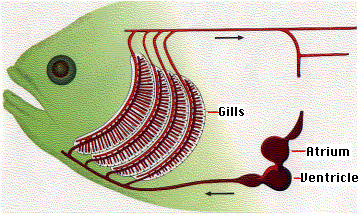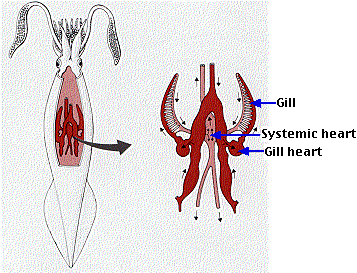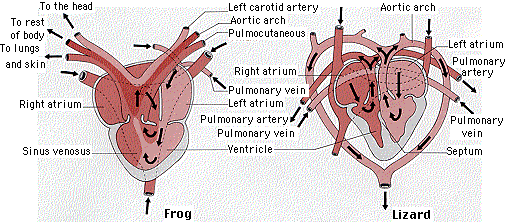15.3K: Animal Circulatory Systems
- Page ID
- 5412
An efficient circulatory system has:
- a fluid, e.g., blood, to carry the materials to be transported
- a system of vessels to distribute the blood
- a pump to push the blood through the system
- exchange organs to carry out exchanges between the blood and external environment, e.g.
- lungs and intestine to add materials to the blood;
- lungs and kidneys to remove materials from the blood.
- The most crucial demand on the circulatory system is the transport of oxygen and carbon dioxide to and from a gas exchange organ such as lungs or gills and the tissues.
- All exchanges between blood and cells occur in the capillaries.
- The force of the pump that pushes blood through the arteries is dissipated as the blood flows through capillaries. Although capillaries are tiny, the total cross-sectional area of all the capillaries supplied by a single artery is much greater than that of the artery itself. Like a rapid, narrowly-confined stream spreading out over a flat plain, the force and velocity of flow diminish quickly.
This creates a problem:
- If the pump is used to deliver blood with force to the gas exchange organ, little force remains to distribute the oxygenated blood to the tissues.
- If the pump is used to deliver blood with force to the tissues, little force remains to send the deoxygenated blood to the gas exchange organ.
The Fish Heart

Most fishes have never solved this problem, which is probably why most of them are "cold-blooded".
- Blood collected from throughout the fish's body enters a thin-walled receiving chamber, the atrium.
- As the heart relaxes, the blood passes through a valve into the thick-walled, muscular ventricle.
- Contraction of the ventricle forces the blood into the capillary networks of the gills where gas exchange occurs.
- The blood then passes on to the capillary networks that supply the rest of the body where exchanges with the tissues occur.
- Then the blood returns to the atrium.
While obviously adequate to the fish's needs, this is not a very efficient system. The pressure generated by contraction of the ventricle is almost entirely dissipated when the blood enters the gills.
The Squid Hearts

This group of marine invertebrates has solved the problem by having separate pumps:
- two gill hearts to force blood under pressure to the gills
- a systemic heart to force blood under pressure to the rest of the body
The Frog and Lizard heart

The Frog Heart
The frog heart has 3 chambers: two atria and a single ventricle.
- The atrium receives deoxygenated blood from the blood vessels (veins) that drain the various organs of the body.
- The left atrium receives oxygenated blood from the lungs and skin (which also serves as a gas exchange organ in most amphibians).
- Both atria empty into the single ventricle.
- While this might appear to waste the opportunity to keep oxygenated and deoxygenated bloods separate, the ventricle is divided into narrow chambers that reduce the mixing of the two blood.
- So when the ventricle contracts
- oxygenated blood from the left atrium is sent, relatively pure, into the carotid arteries taking blood to the head (and brain)
- deoxygenated blood from the right atrium is sent, relatively pure, to the pulmocutaneous arteries taking blood to the skin and lungs where fresh oxygen can be picked up
- Only the blood passing into the aortic arches has been thoroughly mixed, but even so it contains enough oxygen to supply the needs of the rest of the body
- Note that in contrast to the fish, both the gas exchange organs and the interior tissues of the body get their blood under full pressure.
The Lizard Heart
- Lizards have a muscular septum which partially divides the ventricle.
- When the ventricle contracts, the opening in the septum closes and the ventricle is momentarily divided into two separate chambers.
- This prevents mixing of the two bloods.
- The left half of the ventricle pumps oxygenated blood (received from the left atrium) to the body.
- The right half pumps deoxygenated blood (received from the right atrium) to the lungs.
Birds, Crocodiles, and Mammals
The septum is complete in the hearts of birds, crocodiles, and mammals providing two separate circulatory systems:
- pulmonary for gas exchange with the environment
- systemic for gas exchange (and all other exchange needs) of the rest of the body
The efficiency that results makes possible the high rate of metabolism on which the endothermy ("warm-bloodedness") of birds and mammals depends.
Contributors and Attributions
John W. Kimball. This content is distributed under a Creative Commons Attribution 3.0 Unported (CC BY 3.0) license and made possible by funding from The Saylor Foundation.


